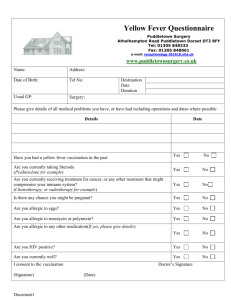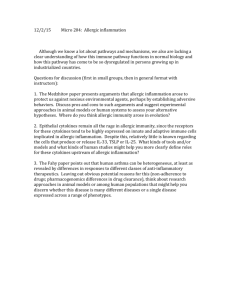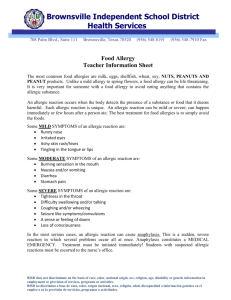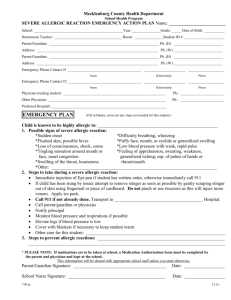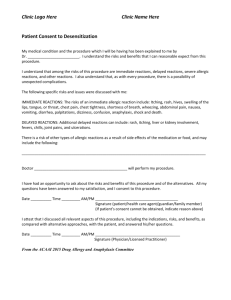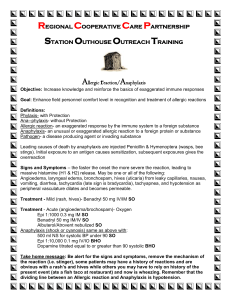cea12389-sup-0001-Supporting
advertisement
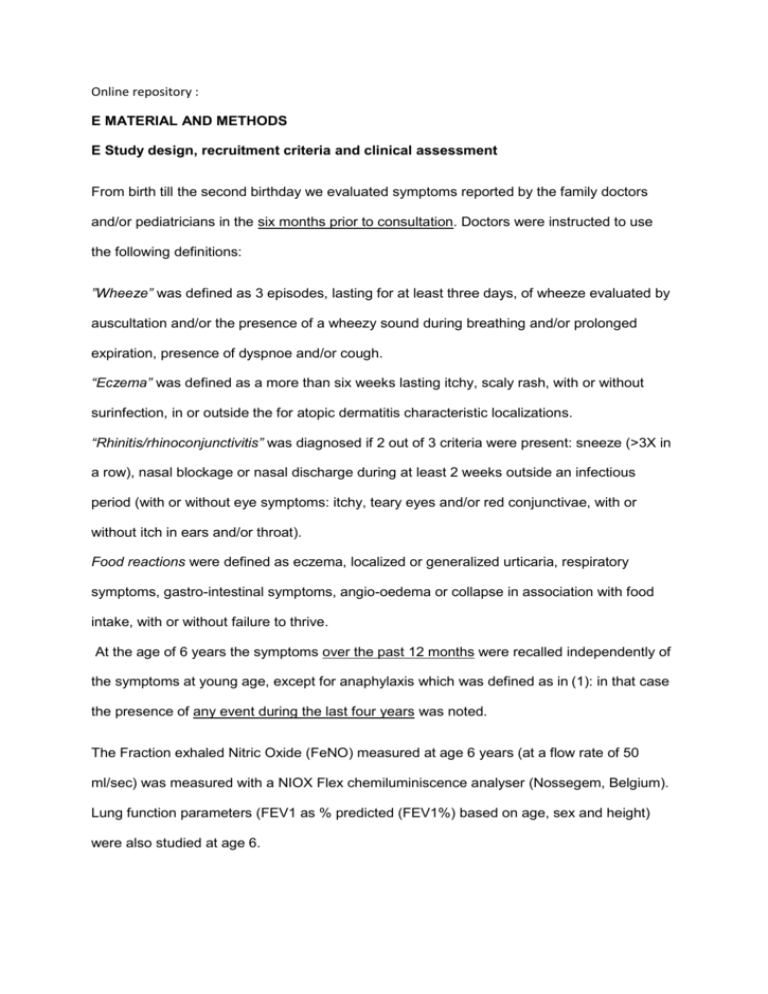
Online repository : E MATERIAL AND METHODS E Study design, recruitment criteria and clinical assessment From birth till the second birthday we evaluated symptoms reported by the family doctors and/or pediatricians in the six months prior to consultation. Doctors were instructed to use the following definitions: ”Wheeze” was defined as 3 episodes, lasting for at least three days, of wheeze evaluated by auscultation and/or the presence of a wheezy sound during breathing and/or prolonged expiration, presence of dyspnoe and/or cough. “Eczema” was defined as a more than six weeks lasting itchy, scaly rash, with or without surinfection, in or outside the for atopic dermatitis characteristic localizations. “Rhinitis/rhinoconjunctivitis” was diagnosed if 2 out of 3 criteria were present: sneeze (>3X in a row), nasal blockage or nasal discharge during at least 2 weeks outside an infectious period (with or without eye symptoms: itchy, teary eyes and/or red conjunctivae, with or without itch in ears and/or throat). Food reactions were defined as eczema, localized or generalized urticaria, respiratory symptoms, gastro-intestinal symptoms, angio-oedema or collapse in association with food intake, with or without failure to thrive. At the age of 6 years the symptoms over the past 12 months were recalled independently of the symptoms at young age, except for anaphylaxis which was defined as in (1): in that case the presence of any event during the last four years was noted. The Fraction exhaled Nitric Oxide (FeNO) measured at age 6 years (at a flow rate of 50 ml/sec) was measured with a NIOX Flex chemiluminiscence analyser (Nossegem, Belgium). Lung function parameters (FEV1 as % predicted (FEV1%) based on age, sex and height) were also studied at age 6. E RESULTS E Clinical patterns and FENO levels in healthy and early (n=17) allergic children As shown in figure E1, up to 80 percent of early allergic children suffered from chronic eczema during the first half year of life. This proportion declined during the second year of life, but rose again to the same level at the age of six years. A substantial proportion of the six year old early allergic children suffered from seasonal allergic eczema. Almost one in five at the age of 12 months presented with wheeze, and at age six, more than 70% of them had (had) recurrent wheeze symptoms during the last year. The proportion with rhinoconjunctivitis in the early allergic children reached around 60% at the age of six years. Gastro-intestinal complaints and urticaria peaked at 18 and 24 months respectively and declined later on. Strikingly, 2 out of 17 early allergic children had at least one episode of well-defined anaphylaxis between age 2 and 6. In contrast, the main symptom in non-allergic children was eczema, although the incidence was below 10% (data not shown) We studied FENO levels at age 6 years (figure E2). Early allergic children had significantly higher FENO levels at the age of 6 years than healthy children. Not surprisingly, FENO levels were highest in children with diagnosed asthma, treated either by short acting beta-2agonists or by montelukast (figure E2). FEV1% values (data not shown) were comparable between all groups. E Sensitization patterns in early allergic children Table E1: Numbers of allergic children sensitized to specific allergens A. early allergic children (N=17) Sensitized to At 12 months At 24 months At 6 years Egg 10 3 2 Potato 4 1 0 Cow’s milk 5 3 1 Peanut 0 2 1 Nuts 0 1 1 House dust mite 4 7 16 Birch pollen 0 1 7 Grass pollen 0 0 8 Alternaria 0 0 2 Animal dander* Cat: 1 Cat: 2 Cat: 6 Dog: 7 Rabbit: 2 Horse: 2 B. late allergic children (N=10) Sensitized to At 12 months At 24 months At 6 years Cow’s milk 0 0 1 Peanut 0 0 1 House dust mite 0 0 5 Birch pollen 0 0 2 Grass pollen 0 0 6 Alternaria 0 0 1 Animal dander* 0 0 Cat: 1 Dog: 2 *all these children with animal dander allergy are multisensitized and among other also sensitized to HDM Legends to figures Figure E1: Clinical symptoms in early allergic children Cohort children were clinically assessed at the age of 6, 12, 18 and 24 months as well as at 6 years. “Early” (E-A) allergic children were defined as symptomatic with relevant sensitization “before age 2 years”. Non-allergic children (N-A) had no sensitizations between birth and age 6 years. Their symptoms were recalled at each visit as explained in material and methods, and the proportions of early allergic children suffering from the indicated clinical symptoms are represented. GI: gastro-intestinal; other: urticaria, angio-oedema or oral allergy syndrome. Figure E2: FENO levels FENO levels in early allergic and healthy children were measured at the age of 6 years. N-A= non allergic; E-A= early allergic. Analysis was done in 41 and 11 children respectively due to missing values by technical reasons. Closed symbols represent infants suffering from wheeze, open symbols infants without bronchial complaints. Dotted arrows indicate infants treated with daily Montelukast, full arrows indicate infants treated with daily inhaled corticosteroids. Bibliography E1. de Swert LF, Bullens D, Raes M, Dermaux A. Anaphylaxis in referred pediatric patients: demographic and clinical features, triggers, and therapeutic approach. Eur J Pediatr. 2008;167:1251-61.

